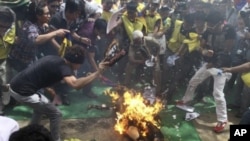A string of Tibetan self-immolation protests has touched the Indian capital in a dramatic way. A young Tibetan is recovering after lighting himself on fire just days before the arrival of China's president here.
For a while, Monday's rally by Tibetan exiles in New Delhi proceeded just as similar events did in the past. Days before the scheduled arrival of the Chinese president, the demonstrators shouted, “Hu Jintao is a dog.”
VOA assistant reporter Neha Sethi was an eyewitness to the shocking scene that soon followed soon.
"Suddenly there was a commotion and this guy came running," he said Sethi. "He was completely on fire. You could see him burning completely. His left arm was burning like a log of wood. You could see cracks on it. There were policemen trying to, you know, put the blanket on him to douse the fire."
The man is 27-year-old Jamphel Yeshi. He is in a Delhi hospital with burns over 98 percent of his body.
This is the second self-immolation by a Tibetan exile in New Delhi in recent months. Another Tibetan suffered minor leg burns in a failed immolation attempt near the Chinese embassy last year.
In Chinese-controlled areas, there has been a much longer string of self-immolations by Tibetan protesters over the past year. Elected Tibetan exile officials say 29 Tibetans have self-immolated in regions under Chinese control.
China refers to the self-immolators as terrorists who are carefully coordinated by “trained separatists.”
Reporter Sethi says protesters gave indications well before Monday's immolation that something unusual was going to happen.
"They were telling me that there's going to be something different from the regular stuff, and that you are going to see something happening today that you have never seen before," said Sethi. "A lot of media people were guessing that it might just be someone self-immolating."
Still, Choedon Lama, regional general secretary for the activist Tibetan Youth Congress, insists the self-immolation was spontaneous.
"It is not pre-planned. We don't know," said Lama. "Even we don't know what is happening and even one more people may come outside. We don't know. There is no plan at all."
Tibetans accuse China of pursuing a policy of deliberate cultural extinction in Tibetan-inhabited areas. Images of Tibetan spiritual leader, the Dalai Lama, are forbidden. Monks and nuns are forced to undergo patriotic “re-education” programs. And Beijing floods the areas with non-Tibetan economic migrants who are accused of discriminating against the local population.
Chinese President Hu Jintao will be in the Indian capital later in the week for a summit of the five so-called BRICS nations -- Brazil, Russia, India, China and South Africa. Tibetan groups say they have more protests planned. But after Monday's immolation, their access to the site of the summit may be severely restricted by Indian police.
Neha Sethi contributed reporting to this article








